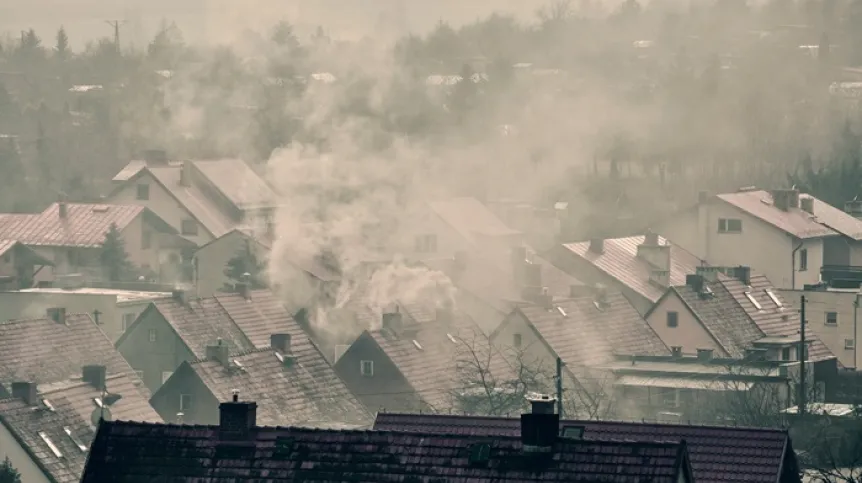
Poland remains one of the most air-polluted countries in Europe, with rising levels of harmful particulate matter posing a serious public health threat, the president of the Polish Smog Alert has warned.
Responding to the government’s 2024 Air Quality Report by the Chief Inspectorate for Environmental Protection (GIOŚ) published last week, Andrzej Guła told the Polish Press agency that despite some improvements, air quality was deteriorating in key areas of the country.
“In Poland, we are still breathing highly polluted air,” Guła said. “For example, particulate matter pollution increased by 7% in 2024. This is a very worrying phenomenon.”
According to Guła, the worsening levels of PM (particulate matter) raise questions about both environmental factors and possible policy failures. “It’s hard to say whether this is the result of meteorological conditions or a trend related to, for example, the increased use of solid fuels for heating buildings,” he said.
GIOŚ reported slight improvements in average annual nitrogen dioxide levels, mainly attributed to reduced emissions from diesel vehicles in cities.
But Guła said this does not reflect the broader picture. “We are still one of the most polluted (by smog) countries in Europe,” he said, pointing out that “50,000 people die prematurely every year due to poor air quality in Poland.”
Guła further warned that high concentrations of particulate matter also carry carcinogenic compounds. “Carcinogenic compounds, such as heavy metals and hydrocarbons, including benzo[a]pyrene, attach to particulate matter,” he said. “In the case of benzo[a]pyrene, we are observing stagnation, not improvement, even though the amount of this substance in Polish air is an absolute record in Europe.”
He added that the current air quality standards in Poland are still far from those recommended by the World Health Organization. “We are very far from the WHO standards. For PM10 particulate matter, the current annual average standard in Poland is 40 micrograms per cubic meter of air; the EU directive is to introduce 20 micrograms in 2030, which is half as much.
According to the WHO, PM10 pollution should not exceed 15 micrograms.”
Guła said the biggest contributors to air pollution remain residential buildings heated with coal and wood, often in outdated furnaces. “In urban centres, pollution from transport, i.e., car traffic, also adds to this,” he said. “Industry also plays a role, although factories and CHP plants have significantly reduced emissions thanks to electrostatic precipitators.”
He called for urgent action on energy efficiency in households and a revitalized national thermal modernization effort. “In order for Poland to meet EU standards by 2030, it is primarily necessary to revive the thermal modernization programme for single-family homes, including the ‘Clean Air’ programme,” Guła said.
The “Clean Air” programme was relaunched in March after a four-month pause due to fraud investigations. The National Fund for Environmental Protection and Water Management reported receiving around 270 notifications of irregularities, leading to reforms such as stricter eligibility criteria and documentation requirements.
Guła said the pause harmed public perception. “The controversy surrounding the programme created an atmosphere of widespread fraud and scams. This was not the case at all. Approximately one million households have already benefited from the programme, and the vast majority of them now enjoy a clean heat source, an insulated home, and lower electricity bills,” he said.
He also highlighted the unresolved issue of the quality of fuels available to consumers. “It is important to implement a quality control system for fuels sold to households, such as pellets. This leads to the situation where pellets burned in modern appliances are contaminated and contain hazardous substances. This causes enormous air pollution,” he said.
In its 2024 report, GIOŚ noted that the average annual limits for PM10 and PM2.5 were not exceeded on a national scale. However, daily PM10 thresholds were breached in three voivodeships: Silesia, Lesser Poland, and Lower Silesia.
The agency also reported that benzo[a]pyrene concentrations in PM10 remained steady compared to 2023, though still well above safe limits.
“These concentrations reached the lowest level since uniform assessments started to be conducted according to EU criteria,” GIOŚ stated.
Nitrogen dioxide levels exceeded the average annual permissible value in just two zones (Kraków and Katowice), compared to four the previous year. Sulphur dioxide levels also declined.
Guła concluded that more aggressive policies are urgently needed to bring Poland into compliance with future EU regulations. “The data presented by the Chief Inspectorate for Environmental Protection should alarm those responsible for air protection policy in Poland, namely the Ministry of Climate and Environment,” he said.
Jacek Stankiewicz (PAP)
jls/ malk/ lm/













